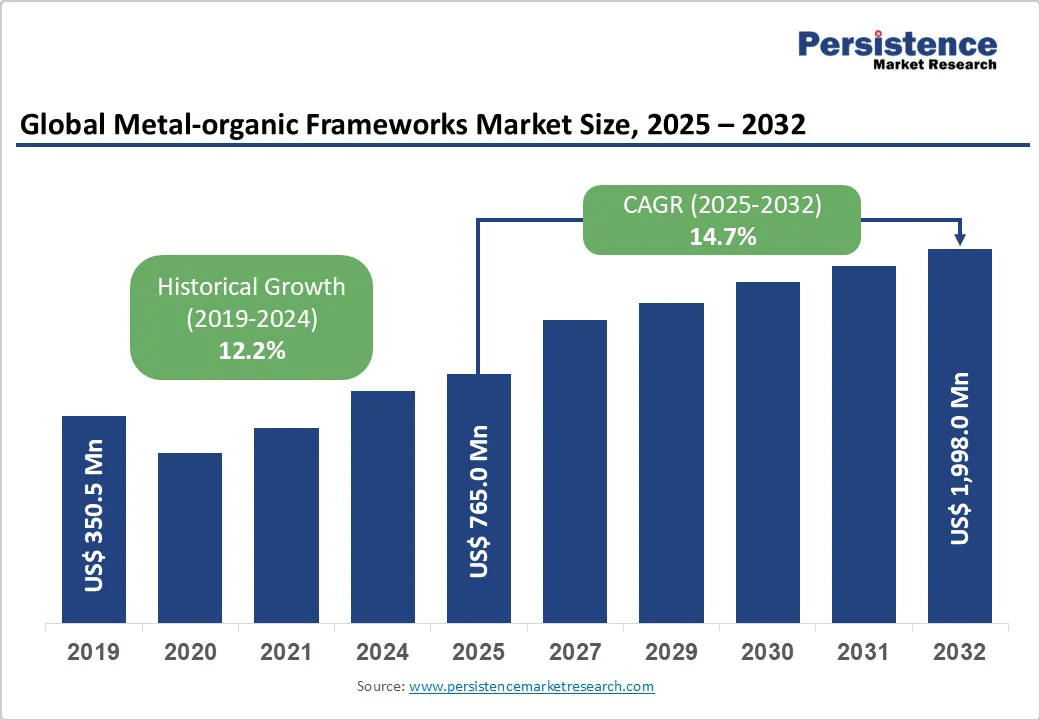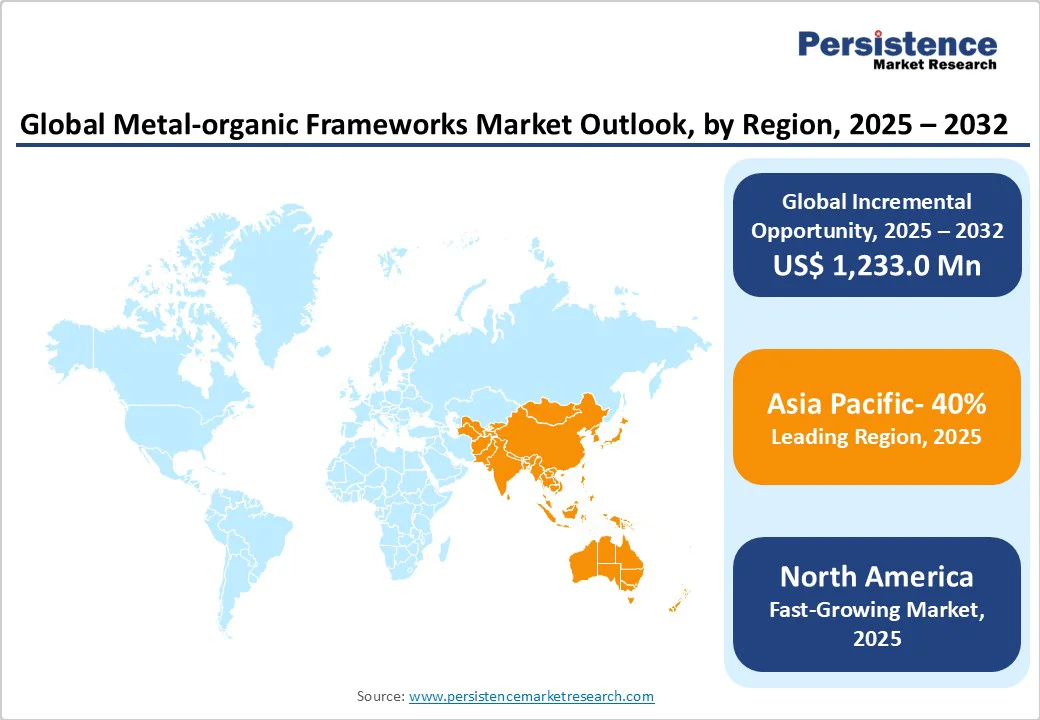ID: PMRREP33702| 189 Pages | 29 Sep 2025 | Format: PDF, Excel, PPT* | Chemicals and Materials

The global metal-organic frameworks market size is likely to value at US$765.0 Mn in 2025 and is expected to reach US$1,998.0 Mn by 2032, growing at a CAGR of 14.7% during the forecast period from 2025 to 2032. The rapid adoption of advanced materials is driven by increasing demand for clean energy solutions, carbon capture technologies, and energy-efficient gas storage. Expanding research funding, industrial applications, and government initiatives supporting sustainable technologies further accelerate the development. Additionally, advances in biomedical applications, including drug delivery and diagnostics, significantly contribute to overall market growth.
| Key Insights | Details |
|---|---|
|
Metal-organic Frameworks Market Size (2025E) |
US$765.0 Mn |
|
Market Value Forecast (2032F) |
US$1,998.0 Mn |
|
Projected Growth (CAGR 2025 to 2032) |
14.7% |
|
Historical Market Growth (CAGR 2019 to 2024) |
12.2% |

The growing global focus on clean energy and carbon capture technologies is a key driver for the metal-organic frameworks market. Governments and research institutions are increasingly investing in advanced materials to reduce greenhouse gas emissions and improve energy efficiency. For instance, the U.S. Department of Energy has funded research programs to develop MOFs capable of capturing carbon dioxide from industrial emissions, demonstrating their critical role in supporting environmental sustainability and reducing industrial carbon footprints.
In clean energy applications, MOFs are being engineered to enhance gas storage and separation, which is essential for renewable energy systems and hydrogen storage. Research efforts by national standards agencies emphasize optimizing MOFs for higher efficiency, stability, and cost-effectiveness. These developments not only support the transition to low-carbon energy but also strengthen the adoption of carbon capture solutions, driving significant growth and innovation in the MOF market.
One of the primary restraints in the metal-organic frameworks market is the high production cost associated with their synthesis. MOFs often require specialized chemicals, precise conditions, and complex manufacturing processes, which significantly increase overall expenses. These costs can limit their adoption, especially for large-scale industrial applications, despite their superior performance in gas storage, separation, and carbon capture.
Scalability challenges further constrain market growth. Producing MOFs at an industrial scale while maintaining consistent quality, stability, and structural integrity remains difficult. Efforts to scale up often face technical hurdles, including controlling crystal formation and ensuring reproducibility. These limitations impact widespread commercialization and slow down the integration of MOFs into cost-sensitive sectors, restricting overall market expansion.
The metal-organic frameworks market is witnessing significant opportunities from advancements in biomedical applications. MOFs’ highly tunable structures and large surface areas make them ideal for drug delivery, imaging, and diagnostic applications. Researchers are exploring their potential to carry therapeutic agents with precise control, improve bioavailability, and target specific tissues, which opens new avenues in personalized medicine. Additionally, MOFs’ biocompatibility and functional versatility enhance their adoption in bio-sensing and cancer therapy research, driving innovation in the biomedical sector.
Emerging markets also present substantial growth potential for MOFs. Rapid industrialization, increasing healthcare investments, and rising awareness of advanced materials in the Asia Pacific, Latin America, and the Middle East are creating new demand. Expanding research infrastructure and government support in these regions are accelerating adoption, offering lucrative prospects for MOF manufacturers. Together, biomedical advancements and emerging markets are key factors shaping the growth trajectory of the MOF industry.
In 2025, zinc-based metal-organic frameworks dominate, accounting for nearly a 35% share. Their widespread adoption is attributed to high thermal and chemical stability, versatile pore structures, and excellent gas adsorption capabilities. These characteristics make zinc-based MOFs highly suitable for applications in gas storage, separation, and catalysis, reinforcing their leading position in the industry.
Aluminum-based MOFs are emerging as the fastest-growing segment due to their cost-effectiveness, scalability, and environmentally friendly synthesis. Their robust frameworks and high surface area enable efficient carbon capture and storage, clean energy applications, and catalysis. Increasing research investments and industrial adoption in energy and environmental sectors are driving rapid growth, positioning aluminum-based MOFs as a critical focus area for manufacturers seeking expansion opportunities.
In 2025, the hydro(solvo)thermal method is dominant, accounting for approximately 50% share. Its widespread adoption is due to its ability to produce high-purity MOFs with well-defined crystalline structures, uniform pore sizes, and excellent thermal stability. These properties make hydro(solvo)thermal-synthesized MOFs highly suitable for gas storage, separation, catalysis, and clean energy applications, reinforcing their leading position in the industry.
The electrochemical synthesis method is the fastest-growing segment, driven by its energy-efficient, scalable, and environmentally friendly approach. Electrochemical techniques allow precise control over MOF formation, enabling tailored structures for advanced applications in carbon capture, sensing, and biomedical fields. Increasing research focus and industrial adoption are accelerating growth, positioning electrochemical MOFs as a key opportunity for manufacturers and researchers.
In 2025, gas storage dominates and accounts for 40% share. MOFs’ high surface area, tunable pore structures, and exceptional gas adsorption capacity make them ideal for storing hydrogen, methane, and other industrial gases. This dominance is driven by the growing demand for clean energy storage solutions and efficient gas separation technologies across energy and industrial sectors.
Drug delivery represents the fastest-growing application segment. MOFs’ biocompatibility, structural versatility, and high loading capacity enable precise delivery of therapeutic agents and controlled release, supporting advancements in personalized medicine. Increasing research in biomedical applications, including targeted therapies and diagnostics, is driving rapid adoption. The expansion of healthcare infrastructure and rising focus on innovative drug delivery systems further fuel growth in this segment.

Asia Pacific dominates, accounting for approximately 40% of the global share. Rapid industrialization, expanding research infrastructure, and increasing investments in clean energy and environmental technologies drive regional growth. Countries such as China, India, and Japan are focusing on advanced material development for applications in gas storage, separation, catalysis, and carbon capture. Additionally, growing awareness of MOFs’ efficiency in energy storage and biomedical applications supports widespread adoption. The combination of strong government initiatives, rising industrial demand, and technological advancements positions the Asia Pacific as the leading region in the global MOF market, reinforcing its strategic importance for manufacturers and researchers.
North America is the fastest-growing region, driven by strong government support for clean energy, carbon capture, and advanced material research. The presence of well-established industrial and research infrastructure, coupled with substantial investments in renewable energy and environmental sustainability initiatives, fuels regional growth. Leading universities and research institutions are actively exploring MOFs for applications in gas storage, separation, catalysis, and biomedical fields. Additionally, increasing adoption of MOFs in energy-efficient technologies and growing awareness of their environmental benefits further accelerate market expansion, positioning North America as a key growth hub for MOF manufacturers and researchers.
Europe holds a notable share in the metal-organic frameworks market, supported by advanced research initiatives, stringent environmental regulations, and strong industrial adoption. Countries such as Germany, France, and the U.K. are investing heavily in clean energy, carbon capture, and sustainable materials, driving demand for MOFs across gas storage, separation, and catalysis applications. Additionally, Europe’s focus on innovation, coupled with collaboration between academic institutions and industries, enhances the development and commercialization of high-performance MOFs. These factors position Europe as a key contributor to the global MOF market, reflecting steady growth and strategic importance alongside other leading regions.

The global metal-organic frameworks market is highly competitive, driven by continuous innovation, strategic partnerships, and technological advancements. Companies focus on developing high-performance MOFs with enhanced gas storage, separation, and carbon capture capabilities to meet growing demand across energy, environmental, and biomedical sectors. Emphasis on research and development, sustainable production methods, and cost-efficient synthesis techniques enables market players to differentiate their offerings. The dynamic competitive environment encourages collaborations with research institutions, fostering innovation and accelerating the commercialization of advanced MOF solutions globally.
The metal-organic frameworks market is projected to reach US$765.0 Mn in 2025, driven by clean energy and biomedical applications.
Demand for hydrogen storage, carbon capture, and precision medicine fuels market growth.
The metal-organic frameworks market will grow from US$765.0 Mn in 2025 to US$1,998.0 Mn by 2032, with a CAGR of 14.7%.
Biomedical advancements and emerging market expansion drive opportunities in drug delivery and catalysis.
Leading players include Strem Chemicals, ProfMOF, MOFWORX, Nanoshel LLC, GS Alliance Co., Ltd., Nano Research Element, Advanced Chemical Synthesis and Manufacturing, IMMATERIAL LABS LTD., Promethean Particles Ltd, and MOF Technologies Ltd.
| Report Attribute | Details |
|---|---|
|
Historical Data/Actuals |
2019 - 2024 |
|
Forecast Period |
2025 - 2032 |
|
Market Analysis |
Value: US$ Mn, Volume: As Applicable |
|
Geographical Coverage |
|
|
Segmental Coverage |
|
|
Competitive Analysis |
|
|
Report Highlights |
|
By Product Type
By Method
By Application
By Region
Delivery Timelines
For more information on this report and its delivery timelines please get in touch with our sales team.
About Author